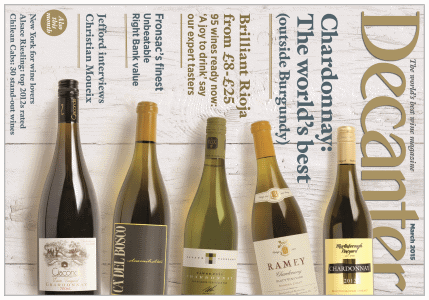

Aside from Chablis, Meursault or Montrachet, which of the world’s leading Chardonnay regions would you turn to, and what are the top wines from each? In a landmark tasting, Stephen Brook heads up an expert panel to find out – and the results may surprise you.
Outstanding wines - Giaconda, Beechworth, Victoria, Australia 2011
A mix of fruit and bacon on the nose with well-judged ripeness. Rich, full-bodied, very ripe and toasty palate – a full-throttle style with power and a good deal of oak, yet it has a lemony freshness and lovely balance.
After a decade studying and working in California, Rick Kinzbrunner returned to his native Australia to seek out the right spot to plant a vineyard. He found it in the remote Beechworth area in northern Victoria, where Brown Brothers had planted many of its vineyards. He liked the clay and gravel soils, especially a sector with significant content of decomposed granite and quartz. From 1982 he planted an old Penfolds clone of Chardonnay with small berries at a high-lying, south-facing site. He was soon making a wine that was widely regarded as one of Australia’s finest. Barrel-fermented, it goes through full malolactic fermentation. Although Kinzbrunner only uses one-third new oak, the wine usually comes over as toasty and powerful, even though he does his best to reduce those characters by ageing the wine in his cool, underground cellar for up to 22 months. This 2011 was acclaimed with even more than the usual enthusiasm by the Australian wine press, and with good reason.
Back to the future for Giaconda's Pinot Noir
30 April 2015A decade or so ago Rick Kinzbrunner was dismayed at the quality of the pinot noir he was producing from his Giaconda vineyard near Beechworth. So dismayed that this figurehead of the Beechworth wine industry actually made several pinots between 2008 and 2012 in which Yarra Valley fruit from the Toolangi Vineyard (for whom he makes its Reserve Chardonnay) was the dominant fraction. This despite the still memorable qualities of estate-grown pinot noir vintages such as 1989, 1991 and 1992, not to mention the first-ever Giaconda wine I tasted, the 1988. I remember this wine as if I tasted it an hour ago. I was with my father, who was equally seduced, and I was immediately convinced Kinzbrunner was a genius.
I’ve just had rather a profound flashback to that very moment, 25 years or so ago. Why? I ripped the top from the 2013 Giaconda Pinot Noir, a wine that is again 100% estate-grown but which is taken from relatively recent plantings at a significantly higher – and therefore cooler – location at the Giaconda site. Here’s a truly stellar pinot noir, but one that talks its site as much as its variety. Having followed the 1989 very closely – and this is the vintage the 2013 most resembles – I speak with genuine confidence that this wine will age superbly, for the long term. It will become more complex and ethereal – which it is already to an extent – and will become firstly more powerful and then more delicate. It will remain elegant and savoury, will retain its effortless natural balance and freshness, and will please many a Burgundian collector, not just because it will age into something more Burgundian than many a Burgundy.
If you have the chance to taste this wine, do so. It has an Old Worldliness and a reserve that takes my breath away. For me it ticks the most important boxes: it’s about the place, the vintage and the maker. And most importantly, no other maker in the world could have created it. I hope Kinzbrunner is as satisfied as I am with his latest creation.
Jeremy Oliver
https://www.jeremyoliver.com